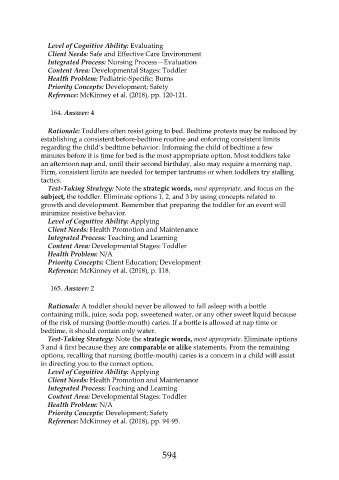Page 594 - Saunders Comprehensive Review For NCLEX-RN
P. 594
Level of Cognitive Ability: Evaluating
Client Needs: Safe and Effective Care Environment
Integrated Process: Nursing Process—Evaluation
Content Area: Developmental Stages: Toddler
Health Problem: Pediatric-Specific: Burns
Priority Concepts: Development; Safety
Reference: McKinney et al. (2018), pp. 120-121.
164. Answer: 4
Rationale: Toddlers often resist going to bed. Bedtime protests may be reduced by
establishing a consistent before-bedtime routine and enforcing consistent limits
regarding the child’s bedtime behavior. Informing the child of bedtime a few
minutes before it is time for bed is the most appropriate option. Most toddlers take
an afternoon nap and, until their second birthday, also may require a morning nap.
Firm, consistent limits are needed for temper tantrums or when toddlers try stalling
tactics.
Test-Taking Strategy: Note the strategic words, most appropriate, and focus on the
subject, the toddler. Eliminate options 1, 2, and 3 by using concepts related to
growth and development. Remember that preparing the toddler for an event will
minimize resistive behavior.
Level of Cognitive Ability: Applying
Client Needs: Health Promotion and Maintenance
Integrated Process: Teaching and Learning
Content Area: Developmental Stages: Toddler
Health Problem: N/A
Priority Concepts: Client Education; Development
Reference: McKinney et al. (2018), p. 118.
165. Answer: 2
Rationale: A toddler should never be allowed to fall asleep with a bottle
containing milk, juice, soda pop, sweetened water, or any other sweet liquid because
of the risk of nursing (bottle-mouth) caries. If a bottle is allowed at nap time or
bedtime, it should contain only water.
Test-Taking Strategy: Note the strategic words, most appropriate. Eliminate options
3 and 4 first because they are comparable or alike statements. From the remaining
options, recalling that nursing (bottle-mouth) caries is a concern in a child will assist
in directing you to the correct option.
Level of Cognitive Ability: Applying
Client Needs: Health Promotion and Maintenance
Integrated Process: Teaching and Learning
Content Area: Developmental Stages: Toddler
Health Problem: N/A
Priority Concepts: Development; Safety
Reference: McKinney et al. (2018), pp. 94-95.
594

